 |
 |
 |
| |
Trichloroacetic Acid an Alternative to Electrocautery for Anal Cancer Precursor?
|
| |
| |
IAS 2021, 11th IAS Conference on HIV Science, July 18-21, 2021
Mark Mascolini
Evidence form a small randomized trial suggests that simply applying trichloroacetic acid (TCA) can treat intraepithelial neoplasia as effectively as electrocautery in people with HIV [1]. Confirmation of this finding would broaden treatment availability for this possible precursor to anal cancer, a persistent threat to people with HIV.
The best approach to screening for and treating anal intraepithelial neoplasia (AIN) remains controversial, especially in people with HIV. Guidelines tend not to offer consistent advice on AIN screening or treatment [2-6]. But even if clinicians decide to treat AIN, the German researchers who conducted this trial observed, treatment options remain limited.
To compare the value of two treatments, Stefan Esser (University Hospital in Essen) and colleagues across Germany conducted a multicenter unblinded randomized trial to compare local treatment with 85% TCA and electrocaustic ablation (ECA) of AIN diagnosed with high-resolution anoscopy and histologically confirmed by targeted biopsies.
Starting in 2015, trial clinicians recruited HIV-positive people with histologically confirmed AIN at 7 German HIV outpatient clinics offering specialized proctologic care. People randomized to TCA or ECA could receive up to 4 repeats of either treatment 4 weeks apart if complete clinical resolution could not be established. To test the noninferiority of TCA to ECA, the primary efficacy endpoint was “clinically and histologically confirmed resolution (or regression) of AIN marker lesions 4 weeks after the last treatment.”
The 155 study participants evaluated so far, 152 of them men, averaged 48.6 years in age and 637 in CD4 count. While 43% of participants had AIN grade 1, the rest had grade 2 or 3 (high-grade) AIN. The investigators randomized 79 people to TCA and 76 to ECA.
The trial team recorded protocol-defined treatment success in 61% of the TCA group after an average 2.6 interventions and 67% in the ECA group after an average 2.3 interventions, a nonsignificant difference (P = 0.34). At weeks 4 and 24 after the last treatment, 78% and 79% of the TCA group attained complete clinical response to AIN, as did 85% and 77% of the ECA group. Rates of histologic resolution or regression 4 and 24 weeks after the last treatment were 74% and 65% with TCA and 75% and 70% with ECA.
Large majorities of both the TCA group and the ECA group (93% and 87%) had an adverse event, but only 7 people in each group had a serious adverse event, and the researchers linked only one serious event to treatment in each study arm (perianal abscess and perianal AIN 3 and syphilis).
The researchers observed that in Germany electrocautery (ECA) can be done only at specialized proctology centers with the necessary equipment. In contract, they called TCA a “rather simple topical treatment” that can be done quickly and without special equipment. They argued that trained general practitioners can perform TCA in outpatient clinics. And TCA clearly costs less than ECA.
Esser and colleagues cautioned that these results are preliminary. They plan subgroup analyses that could yield clues to which treatment should be preferred in which patients. The authors predicted that final results of the trial will influence guidelines for treatment of AIN in people with HIV.
References
1. Bilbilis K, Lax H, Kreuter A, et al. Efficacy and safety of topical trichloroacetic acid vs. electrocautery for the treatment of anal intraepithelial neoplasia in HIV-positive patients (TECAIN): a randomized controlled trial. IAS 2021, 11th IAS Conference on HIV Science, July 18-21, 2021. Abstract PEB113.
2. Siddharthan RV, Lanciault C, Tsikitisa VL. Anal intraepithelial neoplasia: diagnosis, screening, and treatment. Ann Gastroenterol. 2019;32:257-263.
3. Binda GA, Gagliardi G, Dal Conte I, et al. Practice parameters for the diagnosis and treatment of anal intraepithelial neoplasia (AIN) on behalf of the Italian Society of Colorectal Surgery (SICCR). Techniques in Coloproctology. 2019;23:513-528.
4. Medical Care Criteria Committee, with Gina Brown. Screening for anal dysplasia and cancer in patients with HIV. Clinical Guidelines Program. https://www.hivguidelines.org/hiv-care/anal-dysplasia-cancer/
5. Palefsky JM, Brickman C. Anal squamous intraepithelial lesions: Epidemiology, clinical presentation, diagnosis, screening, prevention, and treatment. Last updated July 1, 2021. https://www.uptodate.com/contents/anal-squamous-intraepithelial-lesions-epidemiology-clinical-presentation-diagnosis-screening-prevention-and-treatment
6. Esser S, Kreuter A, Oette M, et al. German-Austrian guidelines on anal dysplasia and anal cancer in HIV-positive individuals: prevention, diagnosis, and treatment. J Dtsch Dermatol Ges. 2015;13:1302-19. doi: 10.1111/ddg.12726.
Abbreviations
AE: Adverse Events; AIN: anal intraepithelial neoplasia; AIN I,11 or III: AIN grade I, II or III; CD4/CDB: Cluster of differentiation 4/8; CDC: Centers for Disease Control and Prevention; ECA: electrocautery; FU4/24: Follow-up week 4/24 weeks after last TECAIN treatment; HGAIN: High-grade AIN; HIV: Human immunodeficiency virus; HPV: Human papillomavirus; HRA: High Resolution Anoscopy; μI: microliter; PLHIV: people living with HIV; RCT: Randomized Clinical Trial; SAE: Serious Adverse Events; SD: Standard Deviation; TCA: trichloroacetic acid
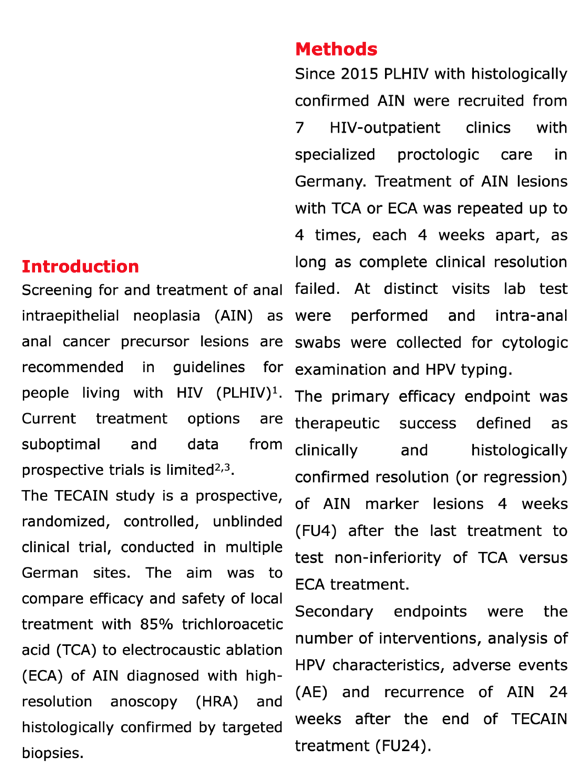
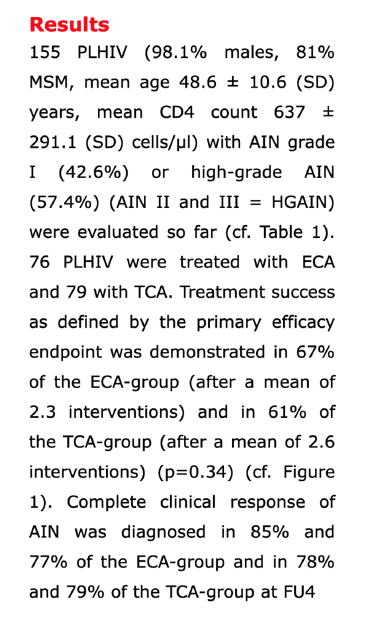
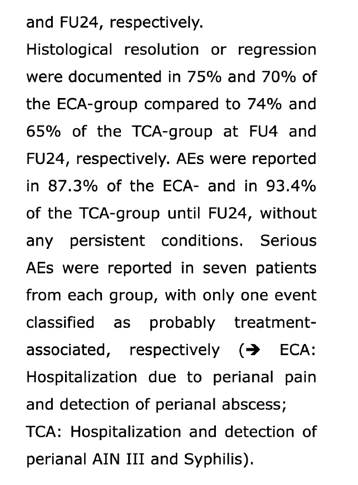
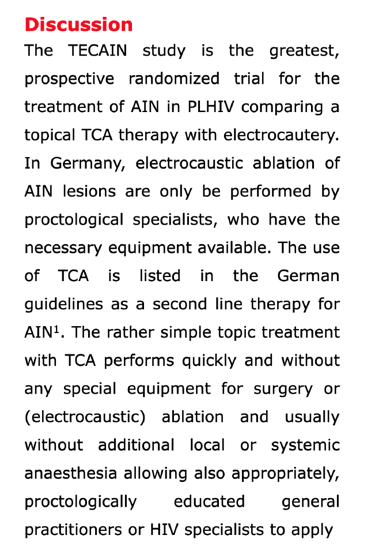
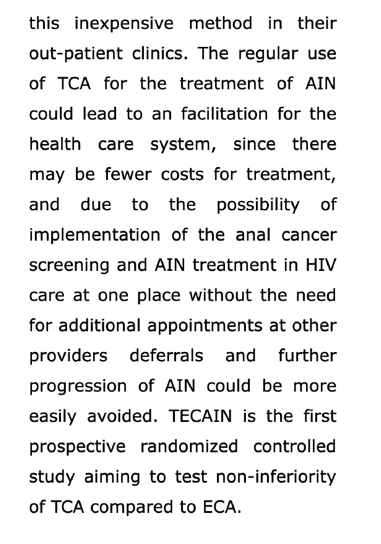
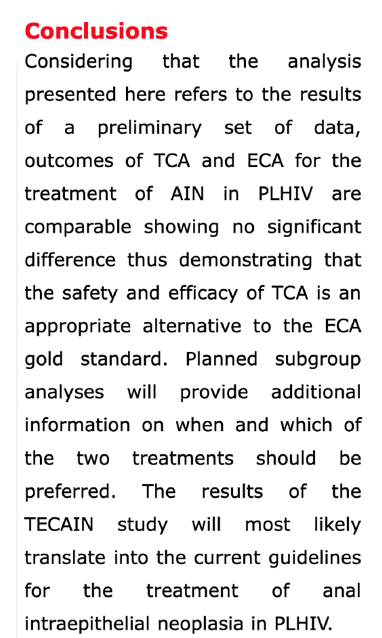
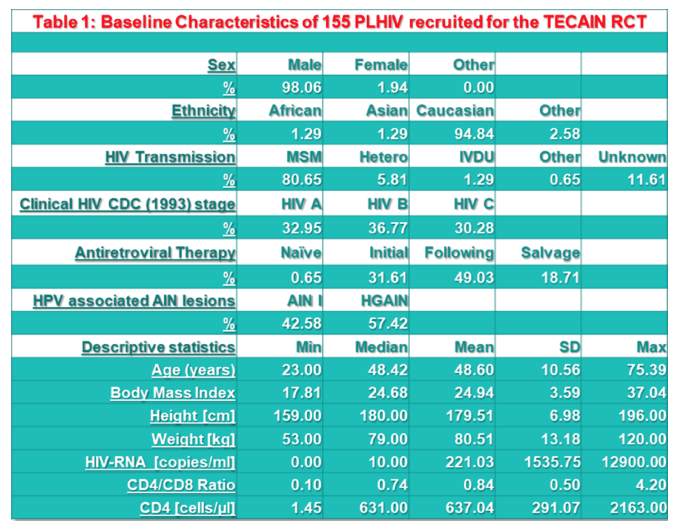
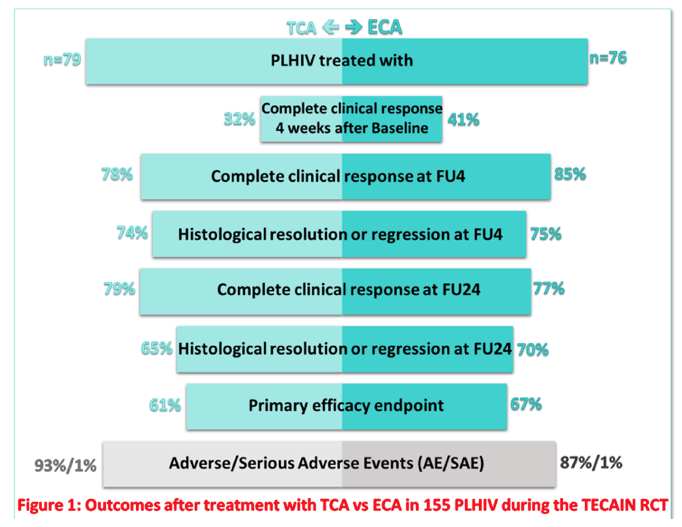
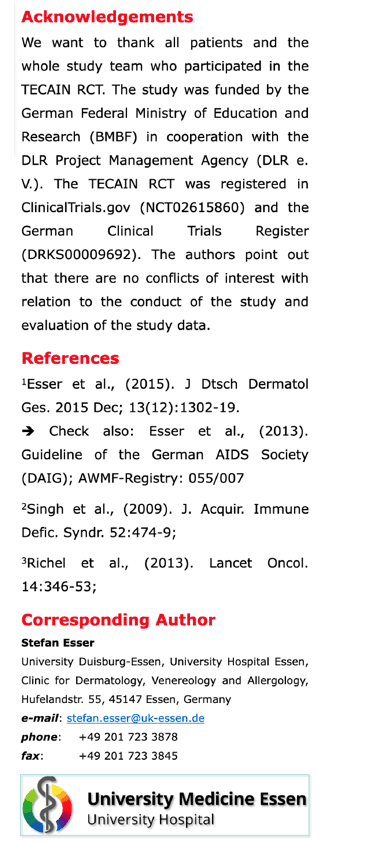
|
| |
|
 |
 |
|
|